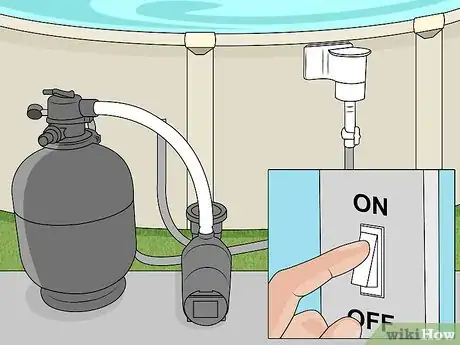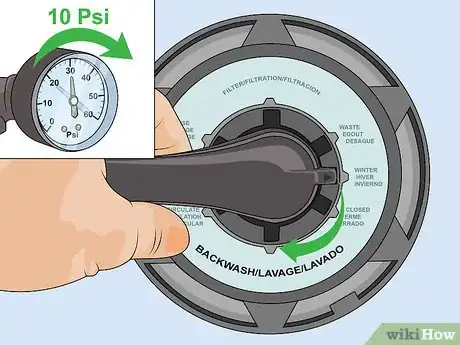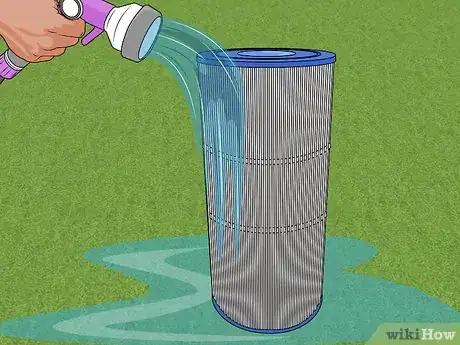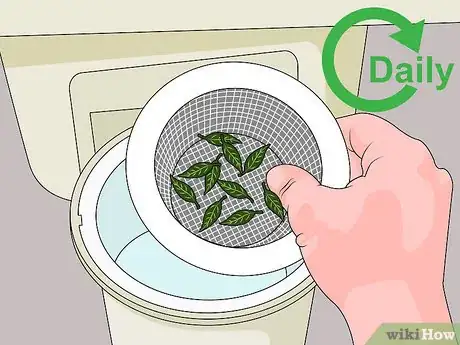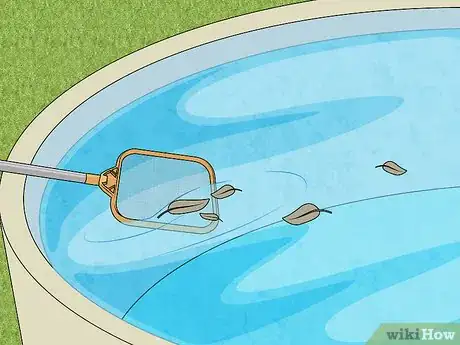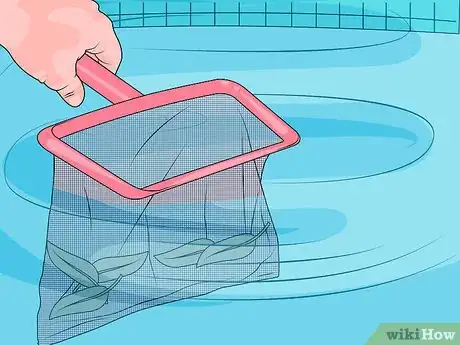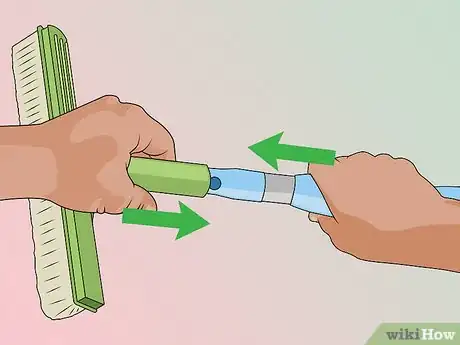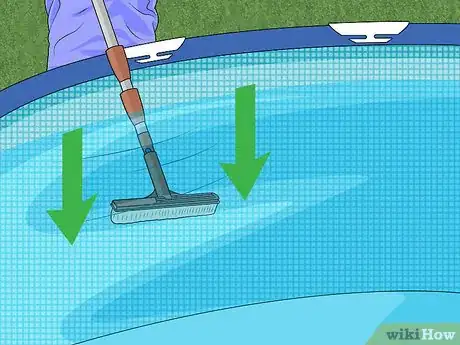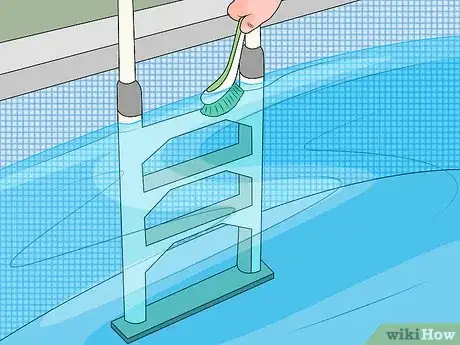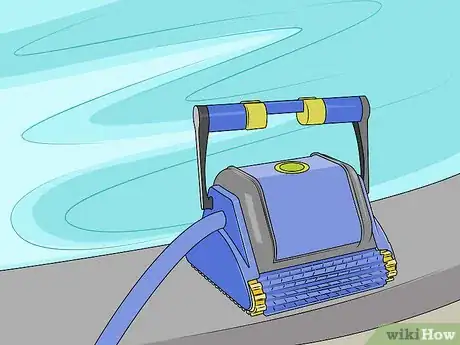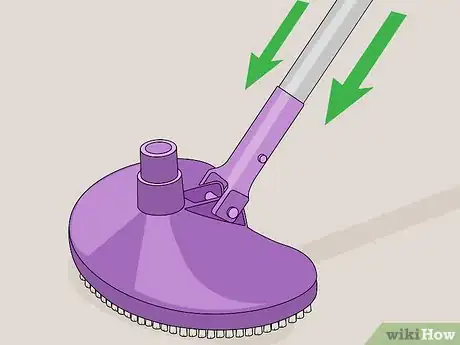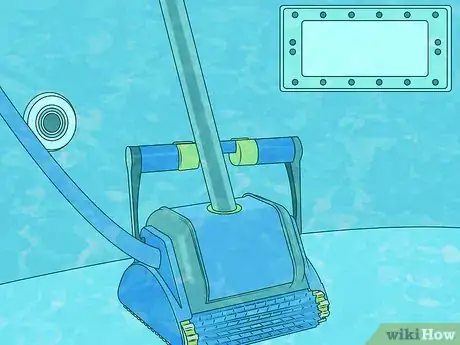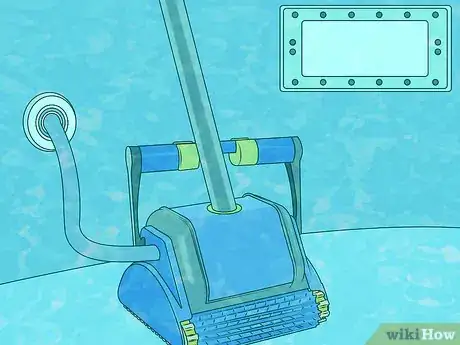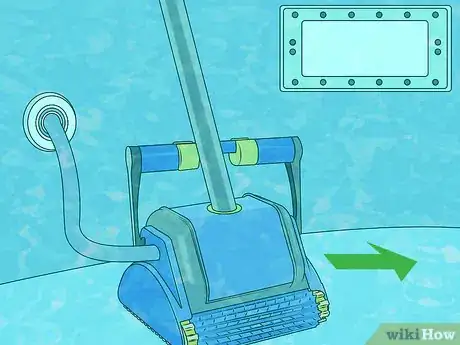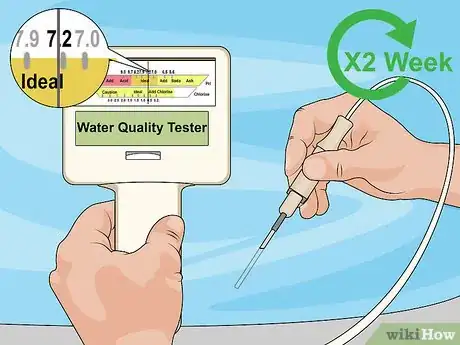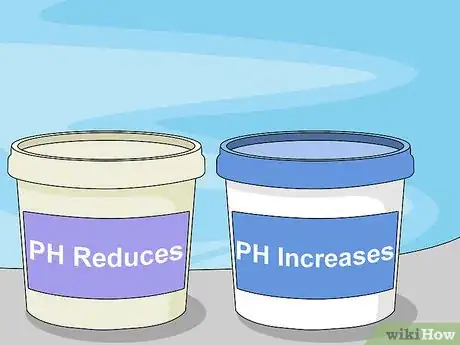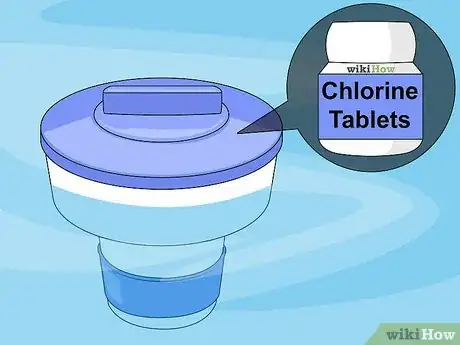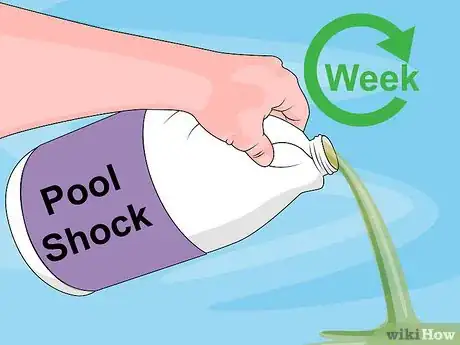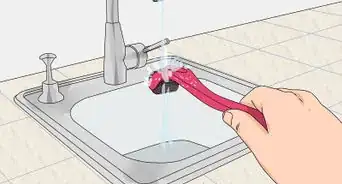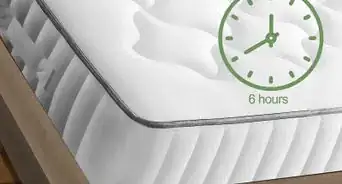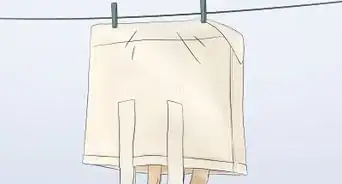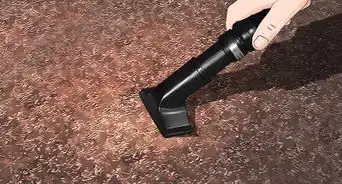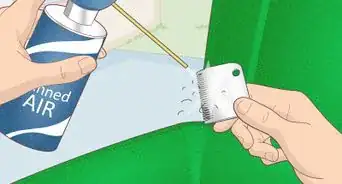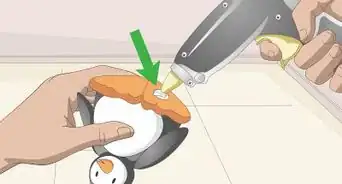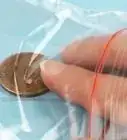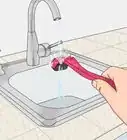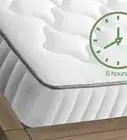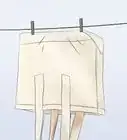This article was co-authored by Matt Daly. Matt Daly is a Landscape Designer and the Founder of Water & Earth Landscape Design, which is based in both Richmond, Virginia, and San Jose, California. With nearly 10 years of experience, he specializes in designing outdoor living spaces, including patios, pools, and fireplaces. Matt also runs a blog where he educates homeowners about landscaping topics: https://www.liveinyourbackyard.com/. He earned his Landscape Design & Horticulture Certification from The University of Richmond, where he also studied Sustainable Landscape Practices.
This article has been viewed 78,422 times.
No one wants to swim in a pool with dirty, cloudy water, so pool cleaning and maintenance skills are crucial for any pool owner. In an above ground pool, filtering and skimming the pool regularly is key to maintaining clean water -- but so are brushing the walls and vacuuming the floors. Most importantly, though, you must maintain proper chemical levels in the pool so the sanitizers work effectively. However, with an above ground pool, you must be sure to use cleaning equipment that is suited for the pool's materials so you don't any damage during the process.
Steps
Filtering and Skimming the Pool
-
1Run the filter pump for at least 8 hours a day. Your above ground pool’s filter pump circulates water throughout the pool and passes it through the filter to remove debris and impurities. The amount of filter time that a pool is going to require depends on the size of the pool and the size of the filter. To ensure that your larger pools stay clean, make sure that the filter pump runs for at least 8 hours a day.[1]
- For the best results, run the pump during the day.
- To ensure that you never forget to turn the pump on or off, use a pool pump timer that can automatically turn it on and off depending on the schedule that you choose.
-
1Backwash the pool when the pressure rises. Dirt and debris can sometimes become trapped in the filter system, which can leave you with dirty water in the pool. If you have a sand or DE filter for your above ground pool, backwash it to reverse the water flow through the system and flush it out so it stays clean.[2]
- You should backwash your pool when you notice that the pressure gauge is 8 to 10 lbs above normal. Consult the manufacturer’s instructions for your filter system if you’re unsure what the normal setting is.
- Make sure to follow the manufacturer’s instructions regarding the backwashing procedures for the pool. In most cases, you’ll need to turn a valve to the proper setting.
-
2Clean the cartridge filter when the pressure rises. If your above ground pool uses a cartridge filter, you must clean the cartridge filter periodically to ensure the system works properly. Turn off the filter, remove the cartridge, and use a garden hose to clean it when the pressure gauge reads 5 to 10 lbs above the normal setting.[3]
- Check the manufacturer's instructions for your cartridge filter system to determine what the normal pressure setting should be so you know when to clean the cartridge.
- Cartridge filters need to be replaced periodically to keep the system running properly.
-
3Clean the pump basket weekly. Your pool’s filter pump has a basket where all the dirt and debris that is filtered out is collected. Once a week, remove the basket from the pump, dump out the contents, and hose it out if necessary.[4]
- Consult your filter system’s manufacturer’s instructions to determine how to remove and clean the pump basket.
- Make sure that you reposition the basket correctly and secure the lid after cleaning it so the filter system will run properly.
- It’s a good idea to clean the pump basket each week after you vacuum the pool.
-
4Empty the skimmer basket regularly. To keep your above ground pool clean, it’s a good idea to have a skimmer basket that attaches to the wall. It will remove light debris and dirt that’s in the water. Make sure to clean out the basket once or twice a day so it doesn’t become clogged.[5]
- If you find that your skimmer basket becomes full fairly easily, you may want to empty it more than once or twice a day.
-
5Use a flat skimmer net for isolated debris. While a skimmer basket works well to remove debris from the pool, it does take time for all of the dirt to circulate to the basket and it may miss some items. To get rid of small amounts of isolated debris, a flat skimmer net on a telescopic pole works well. Drag it across the water surface to lift out the items.[6]
- Even with a skimmer basket attached, it’s a good idea to skim your pool at least once a day.
- If your above ground pool doesn’t have a skimmer basket, you should skim it manually at least three or four times a day.
-
6Remove heavy debris with a leaf rake. If there is a storm in your area or other event that results in a large number of leaves and other heavy debris in your above ground pool, use a leaf rake to remove them. It is a bag that attaches to a telescopic pool pole so you can easily pull it across the surface of the water and get rid of debris.[7]
- A leaf bag is also handy for removing large debris from the bottom of the pool.
Brushing the Pool
-
1Attach a brush head to a telescopic pole. In all above ground pools, there is usually at least one area that has little to no circulation from the filter. Those spots are a prime location for algae to grow, so it’s important to brush your pool. Place a brush head on a telescopic pool pole for the job so it’s easier to reach all of the wall surface.[8]
- To avoid damaging your above ground pool’s walls, use a brush with nylon bristles.
- Depending on the dimensions and setup of your pool, you may prefer to do some of the brushing with a handheld brush from inside the pool.
-
2Brush the walls in a downward motion. After you’ve attached the brush head to the pole, move the brush over the walls in a downward motion to loosen any algae and debris. Make sure to brush all the way around pool so all of the walls are cleaned.[9]
- For the cleanest pool, try to brush it at least once a week.
-
3Use a brush on the ladder. In addition to the walls, it’s important to clean other surfaces in your above ground pool. If there is a ladder, make sure to go over it with the brush as well to remove any residue or algae.[10]
- You may find it easier to brush the ladder with a handheld brush.
- If you have a set of stairs in your pool, make sure to brush those as well.
Vacuuming the Pool
-
1Invest in an automatic pool vacuum. Vacuuming a pool is a critical part of keeping it clean. Doing the job manually, though, can be time-consuming so you may want to invest in an automatic vacuum. It attaches to the pool’s filter system to move the dirt and debris out of the pool and moves around automatically so you don’t need to do any work.
- Make sure to choose an automatic pool vacuum designed specifically for above ground pools so you know that it will work best for your pool’s materials and dimensions.
- If you have an automatic pool cleaner, you can run it daily or every other day so you can be sure that the pool is always clean.
-
2Attach a vacuum head to a pool pole. To vacuum an above ground pool manually, you’ll need a vacuum head with brushes or rollers to remove the dirt and debris from the bottom of the pool. Secure it on the end of a telescopic pool pole that will allow you to move around the entire floor of the pool.
- Before you plan to vacuum your pool, you should skim the surface of any leaves or other debris.
- If you vacuum your pool manually, make sure to do it at least once or twice a week.
-
3Secure a hose to the vacuum and put it in the pool. After you’ve attached the vacuum head to the pole, insert the swivel end of a vacuum hose into the head. Place the vacuum into the bottom of the pool near the skimmer water return outlet.
- Lean the pole against the side of the pool as you’re readying the vacuum in a secure position so it won’t fall into the water.
-
4Place the other end of the hose in the skimmer hole. Hold the free end of the vacuum hose in the water in front of the skimmer return outlet to fill it with water. Wait until there are no longer any bubbles coming from the vacuum head, and insert the free end of the hose into the return outlet.
-
5Move the vacuum along the bottom of the pool to remove debris. With the vacuum hose attached, take hold of the vacuum’s pole and begin moving it across the bottom of the pool. Take your time to ensure that you pick up all of the debris and cover the entire floor of the pool.
- To ensure that you pick up all of the debris, try to overlap your strokes as you move the vacuum to go over each area twice.
Maintaining the Pool’s Chemical Levels
-
1Test the chemical levels several times a week. The chemical levels in your pool play a major role in how clean the water stays. Two to three times a week, use a testing kit to check the pH and chlorine levels to ensure that they are in the proper range. Add the proper chemicals to bring them to the proper levels if necessary.[11]
- A digital test strip reader is usually the easiest way to test the pool’s chemicals levels. Dip a testing strip in the water, and insert into the reader to determine the levels. Other strips change color and provide a chart to help you determine whether the levels are correct.
- It’s crucial that the water’s pH is at the right level to ensure that the sanitizers work properly to keep the water clean. It should be between 7.2 and 7.6 to maintain clean pool water.
- The chlorine level in your pool should be between 1 and 3 parts per million (ppm).
-
2Adjust the chemicals as necessary. If you test the pool's water and the levels aren't correct, you usually need to add chemicals to the pool to address the specific level. In most cases, it will be the pH that requires your attention.[12]
- If the pH is too high, add a pH reducer to the water according to the manufacturer’s instructions.
- If the pH is too low, add a pH increaser to the water according to the manufacturer’s instructions.
- If your pool’s chlorine levels are too low, you should add chlorine to the water.
- If the chlorine levels are too high, stop adding chlorine to the water and leave the water alone for a day or so to help lower the level.
-
3Use a floater to keep a steady amount of chlorine in the pool. Chlorine tablets are the most effective sanitizer for above ground pools because they dissolve gradually to slowly release free chlorine into the water. Fill a floating chlorine dispenser with the tablets according to the instructions, and place it in the pool.[13]
- Make sure to refill the floater on a weekly basis to ensure that there is always a steady supply of chlorine for the water.
- If you prefer, you can install an automatic chlorine feeder for your above ground pool. It attaches to the filter system and uses tablets that dissolve even more slowly so you don’t need to refill it as often as a conventional floater.
-
4Shock the pool weekly to remove contaminants. Even if you try to maintain proper chemical levels in your pool, debris from swimmers, such as sunscreen residue and perspiration, can still build up in the water. Using a shock product can help boost chlorine levels in a hurry to remove contaminants. Add the chemical to the water if your chlorine level falls too low or the water begins to look dull.[14]
- Follow the manufacturer’s instructions regarding how to how add the shock to the water.
- Even if your chemical levels are balanced, you may want to shock the pool after heavy use or a storm to keep the water clean.
- In most cases, you shouldn’t need to shock your pool more than once every or every other week.
- After shocking the pool, you can’t swim it in for a while. In most cases, you need to wait until the chlorine levels fall back to 3 to 4 ppm but consult the shock’s instructions to be sure.
Expert Q&A
-
QuestionHow do you clean an empty swimming pool?
 Matt DalyMatt Daly is a Landscape Designer and the Founder of Water & Earth Landscape Design, which is based in both Richmond, Virginia, and San Jose, California. With nearly 10 years of experience, he specializes in designing outdoor living spaces, including patios, pools, and fireplaces. Matt also runs a blog where he educates homeowners about landscaping topics: https://www.liveinyourbackyard.com/. He earned his Landscape Design & Horticulture Certification from The University of Richmond, where he also studied Sustainable Landscape Practices.
Matt DalyMatt Daly is a Landscape Designer and the Founder of Water & Earth Landscape Design, which is based in both Richmond, Virginia, and San Jose, California. With nearly 10 years of experience, he specializes in designing outdoor living spaces, including patios, pools, and fireplaces. Matt also runs a blog where he educates homeowners about landscaping topics: https://www.liveinyourbackyard.com/. He earned his Landscape Design & Horticulture Certification from The University of Richmond, where he also studied Sustainable Landscape Practices.
Landscape Designer It depends on what your pool is made of, but usually the best way to clean something like that is going to be with your normal household cleaners (like bleach or just hot water). You probably don't want to use a pressure washer (since that would damage vinyl), but some elbow grease, a hose, or even some hot water can really go a long way.
It depends on what your pool is made of, but usually the best way to clean something like that is going to be with your normal household cleaners (like bleach or just hot water). You probably don't want to use a pressure washer (since that would damage vinyl), but some elbow grease, a hose, or even some hot water can really go a long way. -
QuestionWhy is the dirty water being picked up off the floor of the pool being returned to the pool?
 Zachary ThomasCommunity AnswerRemove the cleaner from the pool, disconnect the vacuum parts and turn the pool pump off. Go to the skimmer baskets, clean them and place the cover on. After it is all done, go to the multiport valve and switch it back to filter. Then turn the pump on.
Zachary ThomasCommunity AnswerRemove the cleaner from the pool, disconnect the vacuum parts and turn the pool pump off. Go to the skimmer baskets, clean them and place the cover on. After it is all done, go to the multiport valve and switch it back to filter. Then turn the pump on.
Things You’ll Need
- Telescopic pool pole
- Flat skimmer
- Leaf rake
- Pool brush
- Automatic pool vacuum or manual vacuum head
- Pool testing kit
- Chlorine
- Shock
References
- ↑ http://www.inyopools.com/HowToPage/above_ground_pool_maintenance.aspx?CommentPage=1
- ↑ http://blog.intheswim.com/above-ground-pool-maintenance-guide/
- ↑ http://blog.intheswim.com/above-ground-pool-maintenance-guide/
- ↑ http://blog.intheswim.com/above-ground-pool-maintenance-guide/
- ↑ http://blog.intheswim.com/above-ground-pool-maintenance-guide/
- ↑ http://blog.intheswim.com/above-ground-pool-maintenance-guide/
- ↑ http://blog.intheswim.com/above-ground-pool-maintenance-guide/
- ↑ http://www.inyopools.com/HowToPage/above_ground_pool_maintenance.aspx?CommentPage=1
- ↑ http://www.inyopools.com/HowToPage/above_ground_pool_maintenance.aspx?CommentPage=1
- ↑ http://www.inyopools.com/HowToPage/above_ground_pool_maintenance.aspx?CommentPage=1
- ↑ http://www.inyopools.com/HowToPage/above_ground_pool_maintenance.aspx?CommentPage=1
- ↑ http://www.inyopools.com/HowToPage/above_ground_pool_maintenance.aspx?CommentPage=1
- ↑ http://www.inyopools.com/HowToPage/above_ground_pool_maintenance.aspx?CommentPage=1
- ↑ http://www.inyopools.com/HowToPage/above_ground_pool_maintenance.aspx?CommentPage=1
About This Article
To keep your above ground pool clean, you’ll need to filter and skim it regularly. You’ll want to run your filter pump for at least 8 hours a day to circulate the water and remove debris and impurities. Then, once a week remove the basket from the pump, dump out all of the debris, and hose it down before replacing it. In addition to the pump basket, you should have a skimmer basket that attaches to the wall of the pool and removes light debris and dirt from the water. Clean this basket once or twice a day so it doesn’t get clogged. A flat skimmer net is also convenient to get rid of small amounts of debris. To learn how to brush and vacuum your pool, keep reading!
